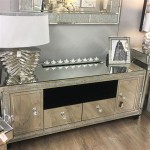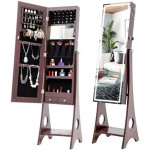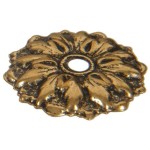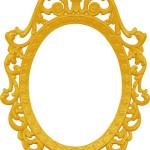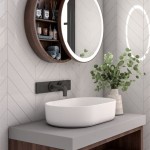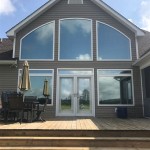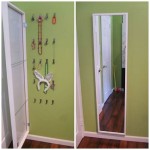How Are Bathroom Mirrors Attached To Wall
Bathroom mirrors, a ubiquitous feature in modern homes, require secure and stable installation to ensure both safety and functionality. Several methods exist for attaching mirrors to walls, each with its own advantages and considerations depending on the mirror's size, weight, and the wall's construction.
Adhesive Mounting
Adhesive mounting offers a convenient and often mess-free method for attaching mirrors, especially lighter ones. Specialized mirror adhesives are formulated to provide a strong bond while remaining flexible enough to accommodate minor movements caused by temperature and humidity fluctuations. This method typically involves applying dabs or strips of adhesive to the back of the mirror before pressing it firmly against the wall. The adhesive often requires a curing period before the mirror can be considered fully secured. It's crucial to choose an adhesive specifically designed for mirrors to prevent damage to the reflective backing.
J-Clips
J-clips are metal brackets shaped like the letter "J," providing a secure grip on the mirror's edges. These clips are typically installed on the wall, with the "hook" portion facing upwards. The mirror is then slid into the clips, securing it in place. J-clips are often used in conjunction with adhesive for added stability, especially for heavier mirrors. They offer a clean, minimalist look as the clips are largely concealed behind the mirror.
L-Brackets
Similar to J-clips, L-brackets offer another mechanical mounting solution. These brackets are typically screwed into both the wall and the back of the mirror frame, providing strong support. L-brackets are suitable for heavier mirrors and can provide a greater degree of adjustability during installation, allowing for precise positioning. They can be more visible than J-clips, though decorative options are available to enhance their aesthetic appeal.
Mirror Mastics
Mirror mastics are specialized adhesives designed for bonding large, heavy mirrors to various surfaces. These adhesives typically have a thicker consistency compared to standard mirror adhesives and provide a high-strength bond. They are often used in conjunction with mechanical fasteners for added security, particularly in areas subject to high humidity or vibrations. Proper surface preparation is crucial for effective adhesion when using mirror mastics.
Mounting Clips and Straps
Mounting clips and straps offer a versatile solution for securing mirrors to walls. These systems typically involve attaching clips to the wall and corresponding straps or brackets to the back of the mirror. The straps are then connected to the clips, securing the mirror in place. This method can accommodate a wide range of mirror sizes and weights, and it often allows for easy removal and reinstallation if necessary. Some systems also offer adjustable features for precise alignment.
Directly Screwing into the Frame
For mirrors with sturdy frames, directly screwing through the frame and into wall studs offers a robust mounting solution. This method requires careful pre-drilling to avoid damage to the frame and accurate placement to ensure the screws align with wall studs. While highly secure, this method is less flexible for adjustments after installation and may not be suitable for all mirror types or wall constructions.
Considerations for Different Wall Types
The choice of mounting method also depends on the wall construction. Drywall requires specific anchors for secure attachment, while concrete or tile walls may require specialized drills and screws. For heavier mirrors, locating and utilizing wall studs is essential for optimal support. Consulting a professional installer may be advisable, especially for large, heavy, or irregularly shaped mirrors, or when dealing with challenging wall types.
Preparing the Wall Surface
Regardless of the chosen mounting method, proper wall preparation is crucial for successful mirror installation. This includes cleaning the wall surface to remove dust, dirt, and grease. For adhesive mounting, ensuring a smooth and even surface is essential for optimal bonding. For mechanical fasteners, accurate measurements and pre-drilling are necessary to avoid damage to the wall and ensure proper alignment.
Safety Precautions
Safety should be a primary concern during mirror installation. Always wear appropriate safety glasses and gloves to protect against sharp edges and potential hazards. When working with heavy mirrors, enlist the help of another person to prevent accidents. Ensure adequate ventilation when using adhesives or mastics, and follow manufacturer instructions carefully for all materials and tools.

How To Install A Mirror Without Frame Merrypad

How To Pick And Hang The Perfect Bathroom Mirror Roomhints

Should You Use Clips Or A Track To Hold Mirror Abc Glass
:strip_icc()/Design_CathieHongInteriorsPhoto_ChristyQPhotography-b2290decbe0e4d0b952f280fb7bdc896.jpg?strip=all)
How To Remove A Bathroom Mirror From The Wall

Diy Bathroom Mirror Frame Without Removing Clips Her Happy Home

How To Add A Frame Your Bathroom Mirror

How To Remove A Bathroom Mirror Lowe S

How To Frame A Mirror

How To Frame A Bathroom Mirror Over Plastic Clips Somewhat Simple

Homlux 36 In W X H Round Frameless Led Light With 3 Color And Anti Fog Frosted Edge Wall Mounted Bathroom Vanity Mirror 621a004796 The Home Depot


